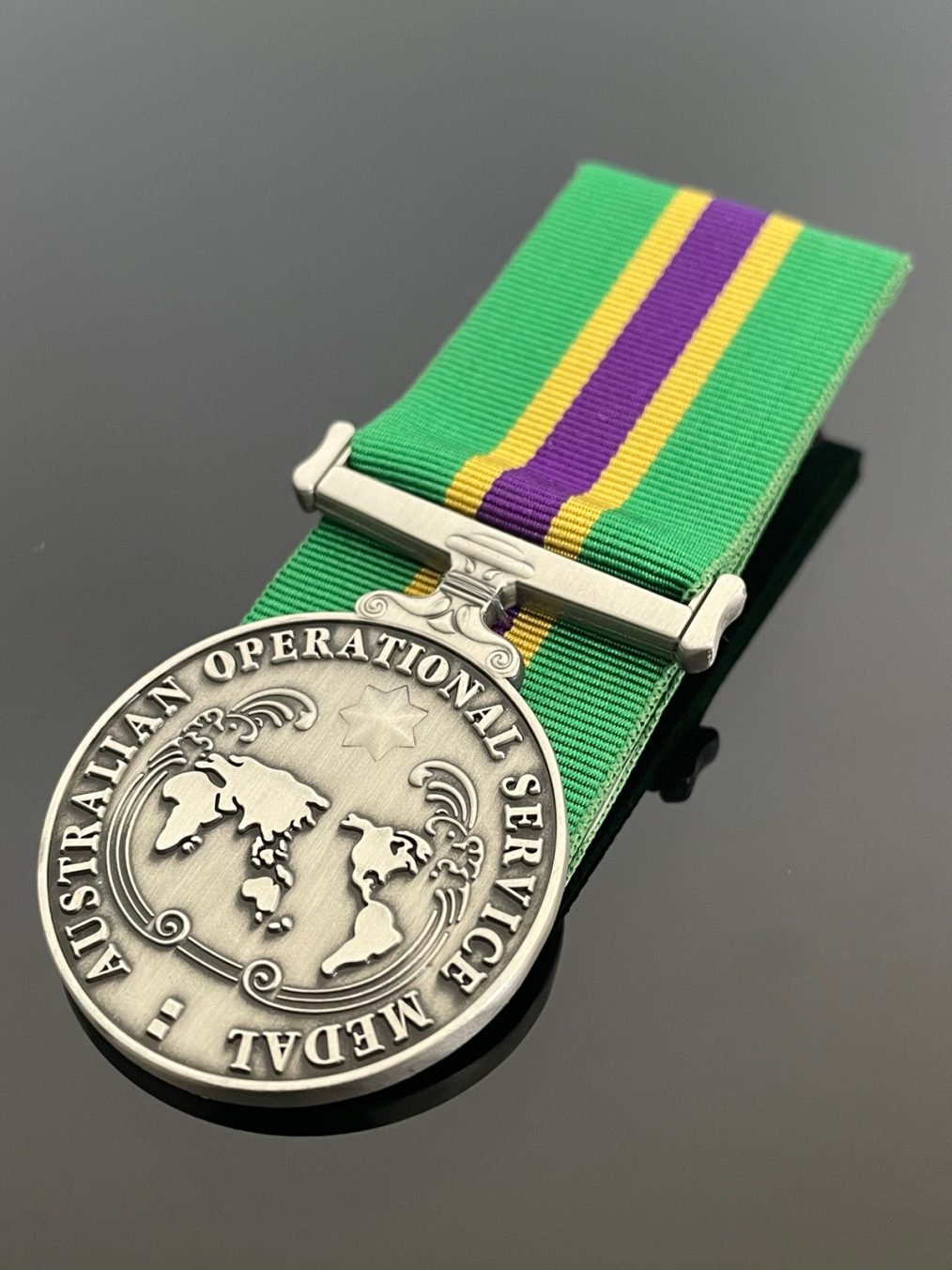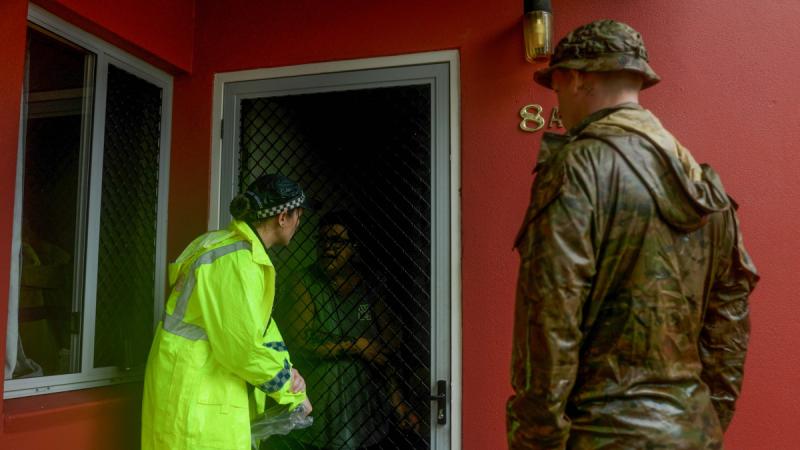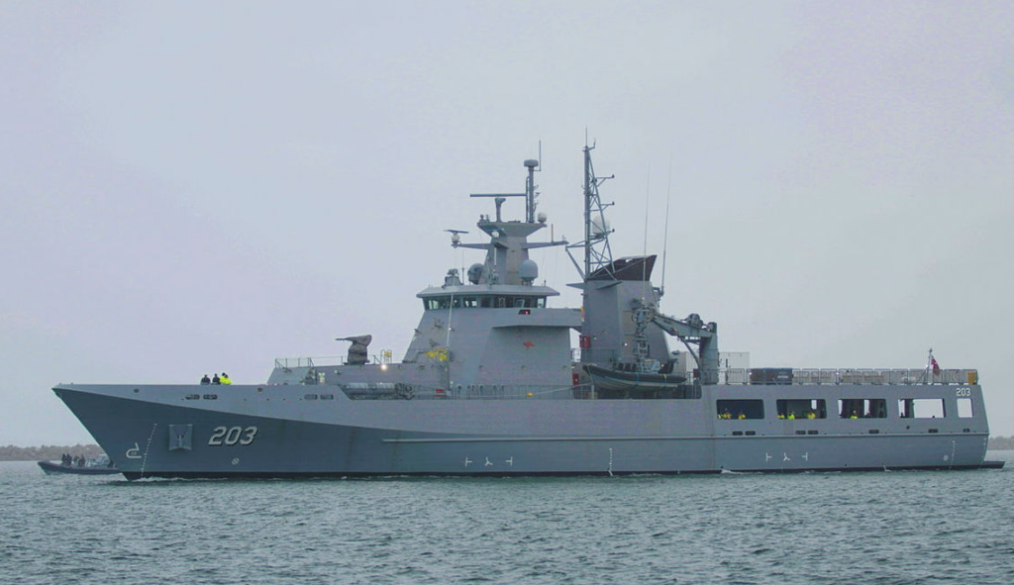Analysis by expert panel of the 1942 HMAS Australia Court Martial. Convenor Professor Tom Frame with panel Mr Mike Carlton, Rear Admiral James Goldrick, Associate Professor David Letts & Associate Professor Cameron Moore. Produced by the Naval Studies Group in conjunction with the Submarine Institute of Australia, the Australian Naval Institute, Naval Historical Society and the RAN Seapower Centre. More details about this video and the Naval Studies Group are available at the UNSW website:
ED: From my inbox … with a comment by Bob Buick MM, “I am like so many of our generation lamenting to how we have been governed this century and how distorted our culture has become because of global Utopian brain snaps developed by the EU and UN and the mass migration of Muslims in Australia and the EU”. Thanks Bob I agree.
A Government in Freefall
Anthony Albanese’s time in office has been one long exercise in incompetence, indecision, and ideological posturing. The man who promised stability and leadership has instead delivered chaos, weakness, and a complete disconnect from the Australian people.
His government is running on fumes propped up by media spin and bureaucratic inertia while real Australians struggle under skyrocketing costs, crumbling infrastructure, and a growing sense that no one in Canberra gives a damn about them. Instead of strong leadership, we have a Prime Minister who refuses to make tough decisions, protects failures within his ranks, and panders to fringe activists while the country drifts into decline.
Incompetence Rewarded; Accountability Abandoned
Albanese’s government is defined by failure, yet no one ever pays the price. Ministers botch their portfolios and keep their jobs. Policy disasters pile up, and the government acts like nothing is wrong.
- Cost of Living Crisis: Australians are drowning under the cost of food, fuel, and housing, while Albanese’s solution is to hand out a few one-off payments and hope people don’t notice how much worse things are getting.
- Housing Disaster: The housing crisis has deepened under his watch, with no serious policies to increase supply or ease rental pressures. Instead, mass immigration fuels the problem while ordinary Australians are priced out of their own cities.
- Energy Chaos: Albanese is blindly pursuing unrealistic renewable energy fantasies, driving up power prices while stubbornly refusing to even discuss nuclear energy—something the rest of the world is moving towards.
- Mass Immigration Mess: Record-breaking immigration is overwhelming infrastructure, health services, and housing, but the government has no plan beyond pretending it isn’t happening.
This isn’t just incompetence. It’s willful negligence.
Weakness on the Global Stage: Kowtowing to China & Foreign Policy Confusion
Under Albanese, Australia’s standing in the world has shrunk. We are led by a government too weak to push back against China, too clueless to strengthen our ties with the U.S., and too distracted by ideological nonsense to focus on national security.
- China is playing Albanese like a fiddle. Trade restrictions are lifted in dribs and drabs to maintain the illusion of “warming relations,” while China continues to expand its influence in the Pacific and undermine Australian interests. Albanese smiles and nods.
- Penny Wong’s Pro-Palestinian, Anti-Western Leanings: Our Foreign Minister is more concerned with pushing her personal agenda than defending Australia’s interests. Her pro-Palestinian rhetoric has alienated allies and emboldened extremism at home, yet Albanese refuses to rein her in.
- Kevin Rudd: An Embarrassment in Washington: The decision to appoint Rudd as U.S. Ambassador was a joke from day one. His arrogance, erratic behavior, and history of insulting American officials make him a liability in our most critical alliance, yet Albanese lets it slide.
Meanwhile, our allies are watching. They see a leader with no backbone, no strategy, and no clue how to protect Australia’s future.
The Cultural Wars: DEI, The Voice, and the Radical Agenda
Albanese’s government is fully committed to the left-wing social engineering experiment that everyday Australians are sick to death of.
- The Voice Referendum Humiliation: Australians rejected The Voice because they don’t want racial division enshrined in the Constitution. Instead of listening, Albanese and his allies act like the vote never happened, pushing the same agenda through the back door.
- DEI Madness: The cancer of Diversity, Equity, and Inclusion (DEI) has infiltrated every part of government, business, and education, prioritizing identity politics over competence. The Albanese government encourages it at every turn.
- Antisemitism Running Wild: The explosion of antisemitism in Australia has been met with weak, half-hearted statements. The radical left factions of his party are in bed with the pro-Hamas crowd, and Albanese won’t push back because he’s too afraid of losing their support.
Australians are sick of being lectured, sick of being divided, and sick of a government more focused on identity politics than real issues.
Energy Policy Paralysis: The Nuclear Debate He’s Too Weak to Have
Albanese’s refusal to consider nuclear energy is pure political cowardice. The world is moving toward nuclear as the only viable long-term solution to energy security—yet in Australia, even discussing it is off-limits.
Instead, we’re stuck with:
- Soaring power prices due to unreliable renewables.
- Energy shortages and blackouts while our leaders preach about “green energy.”
- Zero accountability for an energy policy that is setting Australia up for failure.
Why won’t he even allow a discussion? Because Albanese isn’t a leader—he’s a follower of the activist class, too scared to challenge their ideology, even when it’s wrecking the country.
Conclusion: A Government in Its Death Throes
Albanese’s government is out of fuel, out of ideas, and running purely on spin.
The economy is suffering, national security is being undermined, cultural divisions are deepening, and Australia is weaker on the world stage than it has been in decades. Meanwhile, Albanese does what he does best: nothing.
The only question now is how much damage he’ll do before he’s finally thrown out.
A report released by the Productivity Commission has revealed a 25% increase in persistent homelessness across Australia over the past five years, with nearly 38,000 people now without a stable home for seven months or longer. Among the homeless community, military veterans continue to be disproportionately affected.
Veterans are nearly three times more likely to experience homelessness compared to the general population. Vasey RSL Care, a leading provider of ex-service accommodation, has seen firsthand the growing pressure on their veteran housing services, with increasing demand from veterans and their families in urgent need of stable accommodation.
“Those who have served our nation should not be left without a home, yet too many are struggling to find secure housing after their military service,” says Janna Voloshin of Vasey RSL Care. “We stand ready to be part of the solution. Vasey RSL Care has veteran social housing projects ready to go—we just need the government contribution to ensure those who served are not left behind.”
Despite the clear and urgent need for investment in veteran housing, millions of taxpayer dollars are being allocated to Gaza rehabilitation efforts. While humanitarian aid is important, there is growing concern that Australia’s own vulnerable populations—including military veterans—are being neglected in favour of overseas commitments.
Vasey RSL Care is urging immediate action. “We call on the government to prioritise investment in veteran housing and ensure that no Australian who has worn the uniform is left without a place to call home. It’s time to look after them.”
The Royal Commission into Defence and Veterans Suicide has highlighted the dire situation facing Australia’s ex-service personnel. Veterans are not only three times more likely to experience homelessness than the general population, but they are also over twice as likely to die by suicide. Contributing factors include being single, unemployed, subject to financial strain, and experiencing a greater number of traumatic life events than the broader population.
The question remains: Why is the government prioritising international aid over the wellbeing of those who have served our nation? Ensuring stable housing for veterans is not just a moral obligation but a national responsibility. It is time for the government to reassess its spending priorities and put Australian veterans first.
Media Release
The Australian Government has introduced the Australian Operational Service Medal – Indo-Pacific to formally recognise the vital contributions of Australian Defence Force (ADF) personnel in the region. For decades, ADF members have played a critical role in ensuring peace, stability, and prosperity in the Indo-Pacific, a mission that has only grown in importance given the increasingly complex strategic environment.
To honour this essential service, ADF personnel of all ranks who have completed at least 30 days of operational duty on specific ADF missions in the region will now be eligible for this prestigious award. Among the operations included are Operation Render Safe, where ADF teams work to safely clear World War II-era unexploded ordnance from Pacific island nations, and Operation Argos, Australia’s contribution to enforcing United Nations Security Council sanctions against North Korea.
This recognition will extend to approximately 15,000 current and former ADF members, acknowledging their dedication to regional security and the national interest. Full eligibility details can be accessed via the Defence Honours and Awards website.
A Well-Deserved Recognition
Deputy Prime Minister and Minister for Defence Richard Marles emphasised the significance of the award, stating: “The Australian Defence Force has been engaged in operations across the Indo-Pacific for decades, and it is only fitting that their service be formally recognised. The Government is proud to honour their contributions, particularly as the region’s security landscape becomes more complex. Our ADF personnel play a vital role in safeguarding Australia’s interests and maintaining stability in our region.”
Minister for Defence Personnel Matt Keogh highlighted the historical and ongoing importance of ADF service: “The Governor-General has approved this award at the request of the Government, recognising the service and sacrifice of around 15,000 current and former ADF personnel. These men and women continue the proud legacy of those who have served Australia with distinction.”
This new honour is a well-deserved acknowledgment of the courage, professionalism, and dedication displayed by ADF personnel in the Indo-Pacific. Their efforts ensure not only Australia’s security but also the safety and stability of our regional partners. By awarding this medal, the government reaffirms its deep appreciation for the ongoing commitment of our service men and women.
In early 2024, the Australian Defence Force (ADF) was approximately 4,300 personnel short of its authorised strength of 62,700 permanent members. This shortfall makes the 2040 target of 80,000 personnel increasingly difficult to achieve.
While recruitment challenges are often attributed to competition with other industries and Australia’s low unemployment rate, other factors significantly hinder ADF recruitment. Pay and conditions are frequently cited as an issue, but ADF salaries remain competitive. Australia’s median full-time salary is around $88,500 per year, while ADF personnel—such as a sergeant, fully qualified officer, or a private at pay grade 5—earn above this median. Increasing salaries further may not yield proportional improvements in recruitment or retention.
In 2024, 64,000 individuals applied to join the ADF, yet the average time to complete the recruitment process was 300 days. These figures highlight two major issues. First, a modest increase in successful applicants would have closed the 4,300-personnel gap. Second, the drawn-out recruitment timeline is clearly inefficient. A lengthy recruitment process is particularly problematic in an era of rising geopolitical tensions, where swift expansion of the ADF is critical. Moreover, many high-quality applicants likely abandon the process in favour of faster-moving opportunities elsewhere.
Of the 64,000 applicants, some were recruited, some withdrew, and others were deemed unsuitable. However, it is implausible that none of those rejected applicants could have competently filled some of the 4,300 unoccupied positions. The ADF’s stringent entry standards need reassessment to ensure they align with operational needs rather than bureaucratic inflexibility.
Historically, Australia’s military recruitment was far more inclusive. During World War II, approximately one in eight Australians was deemed fit for service. In contrast, many individuals who fought in past conflicts would be ineligible under today’s stricter standards. The ADF should reconsider its approach to minor or historical health issues, particularly concerning mental health. Advances in medical understanding and treatment have rendered many previously disqualifying conditions manageable. However, the ADF’s conservative stance continues to exclude a growing number of otherwise capable candidates. Expanding mental health support during and after service would enable Defence to recruit from this broader talent pool.
To improve recruitment outcomes, the ADF must allocate greater resources to recruitment and streamline bureaucratic processes. Prioritising high-performing candidates and reducing delays in documentation and medical evaluations would increase the likelihood of securing top talent. Additionally, a thorough review of the ADF’s contract with its recruitment provider, Adecco, could identify areas for improved efficiency.
Ultimately, the ADF must modernise its recruitment standards and processes to reflect current workforce realities. A balanced approach, focusing on an applicant’s current capabilities rather than outdated risk assessments, will better serve Defence’s long-term needs. With these adjustments, the ADF can effectively tap into the existing pool of applicants, making the 2040 goal of 80,000 personnel a realistic achievement.
As residents in Far North Queensland braced for flooding in the wake of heavy rainfall and damaging winds, Army personnel from Townsville’s 3rd Brigade, Lavarack Barracks, supported the Queensland Police Service (QPS) with door-knocking throughout at-risk areas.
Following a request for Defence Assistance to the Civil Community (DACC), soldiers and supporting liaison officers from the 3rd Battalion, the Royal Australian Regiment (3RAR), began the task on February 1.
QPS officers, soldiers and emergency services personnel waded through rising water to visit thousands of at-risk residences, identifying vulnerable people who needed assistance, and encouraging residents to leave before conditions worsened.
Commander 3rd Brigade, Brigadier Ben McLennan, said it was a privilege to be part of the Townsville community and to provide support to the local emergency services.
“We’re fortunate to live and work in Australia’s premier garrison city, and this type of event emphasises the cohesion and resilience of this community, as well as the great work of our local emergency services,” Brigadier McLennan said.
He thanked his soldiers for volunteering to help.
“We’ve had more soldiers volunteer to help than we need and that is a testament to their willingness to get out there and get their socks wet to help the community,” Brigadier McLennan said.
“In our darkest moments, the best of humanity comes out, and you can really see that in the Townsville community during times like this.”
The Ross River Dam reached 155.72 per cent capacity at midday on February 2, and was set to continue rising, prompting evacuation warnings for residents across the region.
This 1967 U.S. Navy documentary looks at the sailors operating on the rivers and in the skies above Vietnam. The Mekong Delta was a hot zone in the war against well organized Viet Cong insurgents, immortalized by the film “Apocalypse Now.” This beautifully photographed film is the real thing — a “slice of life” documentary showing daily operations aboard the Harnett County and on river patrols by air & water. The USS Harnett County (LST-821) served as a floating base in the China Sea for PBR and helicopter patrol operations in the Mekong Delta during the Vietnam War. “REEL HISTORY” will cover battles… military personalities… stories of survival and heroism… and broader stories of campaigns and conflicts produced by or for the U.S. Military. All Original footage. The Real History…
Randwick council cleaners remove antisemitic graffiti from houses in Sydney’s eastern suburbs. Credit: Edwina Pickles
Prime Minister Anthony Albanese is under intense scrutiny as the opposition, led by Peter Dutton, demands answers on whether the Prime Minister was deliberately kept in the dark about the shocking discovery of an explosives-laden caravan—a plot police suspect was intended to target a Sydney synagogue. This alarming development has sent shockwaves through the nation, raising serious concerns about the government’s response to rising threats against the Jewish community.
Opposition Leader Peter Dutton has strongly suggested that police may have withheld critical information from the Prime Minister’s office due to concerns over media leaks. If true, this represents a damning indictment of the government’s perceived inability to handle sensitive security matters effectively. Dutton’s concerns highlight a growing lack of trust in the Albanese administration’s ability to safeguard Australians against escalating threats of antisemitic terrorism.
While Detective Superintendent Darren Newman, who leads NSW Police’s Strike Force Pearl, declined to comment on Dutton’s claims, the broader situation remains deeply concerning. Authorities are investigating a series of disturbing incidents that took place in Sydney’s east on Saturday night, including the discovery of a Mazda with a jerry can and cartons of eggs in Rose Bay, the egging of five women near Bondi Beach, and antisemitic graffiti in Kingsford and Randwick. Although police have stated these events are not directly linked to the caravan plot, they may represent copycat attacks, further fuelling tensions within the community.
The NSW Jewish Board of Deputies has called for urgent reforms, demanding harsher penalties for crimes that specifically target the Jewish population. These attacks are not mere acts of vandalism or mischief—they are calculated attempts to intimidate, terrorise, and destabilise Sydney’s social fabric. Yet, the Albanese government’s response has been underwhelming at best, showing a disturbing lack of urgency in addressing the growing wave of antisemitic threats.
Peter Dutton is right to hold the Prime Minister accountable. Australia cannot afford a government that dithers while extremists seek to instil fear in Jewish communities. Stronger punishments must be introduced, and law enforcement agencies must be given the necessary support to stamp out these threats before they escalate further. The safety of Australian citizens—particularly those targeted by hate-fuelled terrorism—must be the government’s top priority.
Albanese must break his silence and take decisive action. Anything less would be a dereliction of duty.
DEFENCE MEDIA RELEASE
Defence Accepts First Arafura Class Offshore Patrol Vessel for Test and Evaluation
Defence has accepted the first Arafura class Offshore Patrol Vessel, NUSHIP Arafura, for further test and evaluation ahead of its formal delivery to the Royal Australian Navy.
NUSHIP Arafura is the first of class vessel delivered under Project SEA 1180 and has been built by Luerssen Australia at the Osborne Naval Shipyard in South Australia. This project will deliver six Arafura class Offshore Patrol Vessels (OPVs) to the Navy, enhancing Australia’s maritime security capabilities.
The first two OPVs have been constructed at Osborne, with the remaining four currently under construction at Henderson in Western Australia. The Arafura class vessels will form part of the Navy’s Minor War Vessel Fleet, supporting civil maritime security operations and strengthening regional engagement across the Southwest Pacific and maritime Southeast Asia.
Deputy Secretary Naval Shipbuilding and Sustainment, Mr Jim McDowell, highlighted the significance of this milestone in Australia’s naval shipbuilding program.
“The delivery of the first Arafura class Offshore Patrol Vessel to Defence is a major step forward in the Australian Government’s commitment to enhancing the Australian Defence Force’s capability through local shipbuilding,” Mr McDowell said.
“This milestone underscores Defence’s dedication to successfully managing complex projects to deliver critical capabilities, built right here in Australia.”
NUSHIP Arafura will now proceed to its homeport at HMAS Stirling in Western Australia, where it will undergo final preparations ahead of its commissioning into the Royal Australian Navy fleet later this year.










